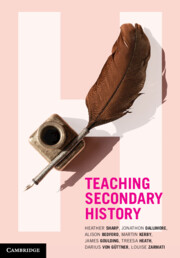Refine search
Actions for selected content:
3 results

Testimony and Historical Knowledge
- Authority, Evidence and Ethics in Historiography
-
- Published online:
- 29 July 2025
- Print publication:
- 21 August 2025
-
- Element
-
- You have access
- Open access
- HTML
- Export citation
Chapter 2 - Knowledge, historical thinking and skills
- from Part 1 - What is history?
-
-
- Book:
- Teaching Secondary History
- Published online:
- 15 October 2021
- Print publication:
- 22 November 2021, pp 26-47
-
- Chapter
- Export citation

Teaching Secondary History
-
- Published online:
- 15 October 2021
- Print publication:
- 22 November 2021
-
- Textbook
- Export citation
